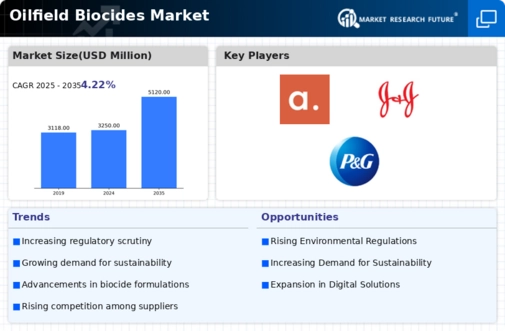Market Trends
Key Emerging Trends in the Oilfield Biocides Market
The oilfield biocides market is undergoing significant shifts that are reshaping the industry and influencing its growth trajectory. One prominent trend is the increasing demand for oilfield biocides, driven by the expanding oil and gas exploration and production activities worldwide. Oilfield biocides play a critical role in controlling microbial growth and preventing microbial-induced corrosion, biofouling, and souring in oil and gas wells, pipelines, storage tanks, and production facilities. With the proliferation of hydraulic fracturing operations, water injection, and enhanced oil recovery techniques, there is a growing need for effective biocidal treatments to maintain asset integrity, ensure production efficiency, and comply with regulatory requirements. As the oil and gas industry continues to expand into challenging environments and reservoirs, the demand for high-performance oilfield biocides is expected to rise, driving market expansion across diverse sectors.
Moreover, there is a growing emphasis on environmental sustainability and regulatory compliance in the oilfield biocides market, driven by increasing scrutiny from regulatory authorities and public stakeholders. Oilfield operators are facing stringent regulations and guidelines aimed at minimizing the environmental impact of biocidal treatments and protecting public health and safety. Additionally, there is growing concern about the potential ecological and human health risks associated with conventional biocides such as chlorine, glutaraldehyde, and quaternary ammonium compounds. As a result, there is increasing demand for environmentally friendly and biodegradable biocide formulations that offer effective microbial control while minimizing adverse environmental effects. This trend towards green chemistry and sustainable biocidal solutions aligns with the industry's commitment to responsible stewardship of natural resources and ecosystems.
Furthermore, the market is witnessing increasing adoption of advanced biocide formulations and delivery systems that offer improved performance, efficiency, and safety. Manufacturers are investing in research and development to create innovative biocide chemistries, encapsulation technologies, and slow-release formulations that provide long-lasting microbial control and reduce the frequency of biocidal treatments. Additionally, advancements in nanotechnology, microencapsulation, and controlled release mechanisms are enabling the development of biocidal additives that can be incorporated into drilling fluids, completion fluids, and production chemicals to provide continuous protection against microbial contamination. As oilfield operators seek cost-effective and sustainable solutions for microbial control, the demand for advanced biocide formulations is expected to grow, driving market expansion and fostering innovation in the industry.
Moreover, the market for oilfield biocides is experiencing a shift towards digitalization and data-driven decision-making in biocide management and application. With the rise of digital oilfield technologies such as IoT (Internet of Things), big data analytics, and predictive modeling, oilfield operators are leveraging real-time monitoring, remote sensing, and predictive algorithms to optimize biocide dosing, scheduling, and efficacy assessment. Additionally, digital tools enable proactive management of microbial risks, early detection of microbial-related problems, and optimization of biocide usage to minimize costs and environmental impact. This trend towards digitalization and automation in biocide management is driving investment in digital technologies, data analytics, and cybersecurity solutions in the oil and gas industry.







Leave a Comment